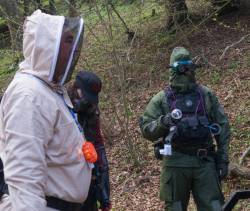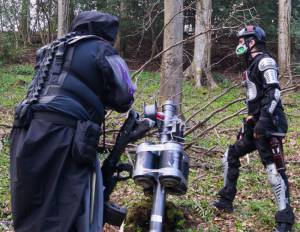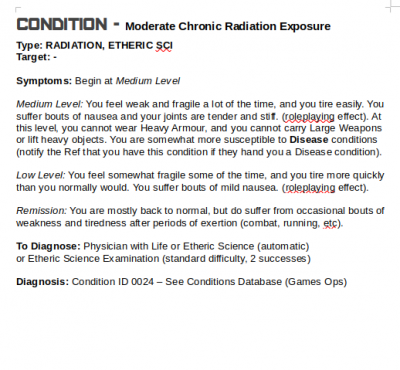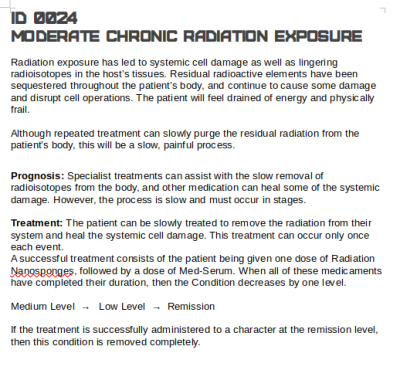Tag Cloud:
User Tools
Sidebar
Table of Contents
Conditions
Conditions are Orion Sphere LRP’s framework for representing more complex or long term effects that can happen to characters. The sort of effects that are modelled by Conditions are generally more than simple Calls are able to handle - exotic diseases, complex psionic effects, broken bones or the strange consequences of Precursor technologies. Conditions are usually given to characters by Referees or other members of the Game Team in response to what they do in the game, but may come from other sources such as players or NPCs. Sometimes a Condition is applied immediately in response to an in-character action, sometimes it may occur as a result of an unfavourable result in a Card Draw Action (such as in Surgery or destruction of a starship), sometimes a Condition may develop after the action that triggered it. Conditions take two forms - Sleeved Condition Cards and larger Condition Sheets. They do share a number of rules elements on how they are dealt with.
Game Rules
- All Conditions have some basic information on how they affect you.
- When they gain a Condition, players should fully read the exposed information as soon as it is convenient.
- Some Conditions may have other instructions on how they work, which will be indicated on the Condition.
- All Conditions have one or more Keywords, such as RADIATION, TERRAN, etc.
- These Keywords are either Type Keywords or Target Keywords.
- Some Species may react differently to Conditions with certain Type Keywords.
- Conditions with Target Keywords only affect the named Target Species or a Species that has one of the Condition’s Target Keywords.
- You must retain the Condition as long as you are in an IC area.
- All Conditions must be Diagnosed to discover more information.
- Some Diagnoses require a Card Draw Action.
- Conditions can usually be removed using Medicaments or a successful Physician's Card Draw Action (Surgery).
- Conditions can be Sampled by Scientists using a Scanner.
- Not all Conditions can be removed.
- Some Conditions must be researched to discover a treatment or cure.
When you first acquire a Condition you should take the time to read the immediate effects on the Card or Condition sheet. You should do this as soon as is convenient after you gain the Condition - but you do not need to read it in the middle of an IC conversation, firefight or otherwise in the middle of the action. Once you gain a Condition card or sheet, you must keep it with your character whenever you are in an In-Character area.
A Condition will always have some information that is visible immediately; a name or title for the Condition (which may be quite vague); one or more Keywords; information on how the Condition affects your character (which may be a roleplay or mechanical effect); what is required to Diagnose the Condition. It may also have a Progression Trigger, which will be some instructions on what to do if something else occurs (Eg. “If this Condition has not been removed after 8 hours see a Referee”).
All Conditions will have one or more Keywords on them. Keywords on Conditions are either Type Keywords (like TOXIC, LIFE SCIENCE, DISEASE, DEADLY) or Target Keywords (like MINERAL, TERRAN or PSIONIC). In most cases, these Keywords just interact with other character’s abilities, so you don’t need to do more than remember you have them.
A Type Keyword identifies the nature of the Condition - what kind of “thing” it is and possibly how serious it is. Some Species interact with some Types of Condition differently to other characters - how they do so is explained in their individual Species Rules, and should be repeated on your Character Passport. For example, Xak’Noth are less likely to be affected by RADIATION Conditions, while Vikaas Aquerna can shrug off the first INJURY Condition that affects them each day. If your character has special abilities that relate to Keywords on a Condition you acquire, please let the Referee know as soon as is practical.
A Condition with one or more Target Keywords only affects characters in the target group. Sometimes a Target Keyword is for a specific Species (Like Terrans or Elysians), other times the Target Keyword will be one of the Keywords shared by more than one species (like Humanoid, Plant or Psionic). If you are given a Condition with Target Keywords that don’t apply to your character at all, inform the Referee.
Diagnosis
Once you have gained a Condition, you can find out more about it by having a character with the appropriate skills or equipment perform a Diagnosis. The Condition should indicate what skills or equipment are required to Diagnose it - on a Card this will usually be located towards the bottom of the card, while on a Condition Sheet, it will be after the “To Diagnose” heading. Most Conditions require a character with the Physician skill to diagnose them, but may require that character to have additional ranks in other skills (generally Science Specialisations). Conditions can also be diagnosed by a Scientist using a Scanner to perform an Examination. You can diagnose Conditions that affect you by yourself if you have the appropriate skills and equipment.
Many Conditions can be automatically diagnosed by a character with enough ranks in the relevant skills or certain specific equipment - others require one or more successes in a Card Draw Action - this will be indicated on the Condition. A character can only attempt a diagnosis of each Condition once per event.
When a Condition is successfully Diagnosed, then the Diagnosing character can learn more information about it. If the Condition is a sleeved Card, they may flip the card over in the sleeve and read the back side, which will have a “Diagnosed Condition” heading. If the Condition is a Sheet, they can read the reference number of the Condition and bring it to Games Ops for the full description of the Condition with that reference number (In-character, they are consulting reference materials for the Condition).
Diagnosis will usually reveal more information about how the Condition is affecting the character with it, how to treat it, and the likely prognosis. Some Conditions are unknown to the general medical community of the Orion Sphere - either they are completely new or only known to a select group. In this case, the information gathered from a Diagnosis will be lacking in much of the usual detail, and to gather more information or identify a treatment or cure a Sample of the Condition must be Researched by a Scientist.
Treatment
Once a Condition has been diagnosed, there will usually be some information about how it can be removed (cured) or treated. In many cases, this will require some Medicaments to be administered to the character, or a Surgery performed, or both. Surgery is a Card Draw Action performed by characters with the Physician skill - the Condition will indicate how difficult it is to treat by this method, by detailing how many Black, Yellow, Red or Green cards to add to the Deck, and how many successes are required to remove or treat the Condition. A character can only attempt to remove a given Condition as the Lead Character once per day.
Simple Conditions can mostly be self-refereed - if a Card Draw Action is not involved, then the characters involved can diagnose and treat the Condition without a Referee, and should hand the Condition and any resources used in the treatment back to a Referee or to Games Ops when it is convenient.
Some Conditions require complex treatments - such as Card Draw Actions, Medicaments given over several events, or other more outlandish methods. The Condition lammie or Diagnosis sheet should indicate all the requirements for a treatment. Some Conditions cannot be removed or even treated once a character has them - in particular Conditions gained after drawing a Black card during Surgery are almost always incurable.
Psionic Conditions
Psionic Conditions are a special sub-class of Conditions in that they are generally given to characters by other player characters. Many psionic powers have effects that are complex and may linger for several events, so they are represented in the game by Condition lammies or Condition Sheets. Generally, Psionic Conditions work in all ways like normal Conditions - they have an effect on the character who has them, they can be Diagnosed to gain more information (usually with a psionic power such as the Empathosomatics power Psionic Analysis) or removed in a similar manner to other Conditions. The main way in which they differ is that some Psionic Conditions have flexible elements that are defined when they are given to the target character. These flexible elements must be defined and recorded on the Condition when the lammie or sheet is given to the affected character.
Advanced Rules - Condition Sheets
Conditions represented by Condition Sheets tend to represent more complex Conditions, lasting over several events or possibly a character’s entire lifetime. Condition Sheets have a few specific rules that encompass this greater complexity and longevity.
Diagnosing Condition Sheets
Condition Sheets represent more obscure and strange Conditions that very few physicians or scientist would automatically know everything about in the field. Even a successful diagnosis requires consulting medical databases, chasing down a handful of reports and cross-referencing them with the symptoms they discovered.
When a character successfully diagnoses a Condition Sheet, they get a number reference for that Condition. All Conditions (even lammies) have a reference number, but they are only of use to players on a Condition Sheet. The diagnosing player can then take that reference number to Games Ops to be allowed to read the corresponding Diagnosis Sheet for it. They can take notes on the contents of the Diagnosis Sheet, but cannot take it away from Games Ops. The information on the Diagnosis Sheet may change over the course of different events, as the information held by the general medical community may change over time. The only up-to-date source of information is held at Games Ops.
Levels and Progression
Some Conditions represented by Condition Sheets have different levels of progression of the Condition. The Condition may get worse over time or when exposed to certain triggers, or it may fade away with treatment or on its own. When a Condition Sheet has more than one level, it will usually be indicated on both the Condition Sheet and also the Diagnosis Sheet. Most Condition Sheets with levels will indicate at which level the character with the condition starts at - they should note on the Condition Sheet what level they are currently at.
The Treatment for a Condition with levels will generally reduce the severity of the Condition by one or more levels, and may have a limit on how many times at each event it can be performed. For example, Chronic Radiation Exposure starts at a high level, and can be treated once each event to reduce it to the next level down - symptoms gradually decrease until the Condition is entirely removed.
Researching Conditions
Some Conditions are novel, exotic or otherwise unknown to the general medical community. In these cases Diagnosis will reveal very little about the Condition, and likely indicate that more information can be gathered through Research.
To Research a Condition, a Scientist character with a Scanner needs to first Sample it from the character who has it. Sampling is a Card Draw Action that Scientists with a Scanner can perform - Ranks of Science Specialisation that match the Science Type of the Condition will grant additional Green cards. Once the Condition has been Sampled, Scientist characters can submit the Samples in their downtime pack to perform Research on the Condition. Once the Research has been completed, the Researcher will be given information on the Condition and may learn any Treatment for it.
A Treatment or Cure for a Condition may also require Research to develop and manufacture - some Conditions require highly specific cures that must be tailored to each patient, and creating these cures is represented by the Research action in downtime.
Character Options
- Some Conditions may grant the opportunity to make the Condition a permanent part of your character.
- Your character may request to start the game with a Condition or to acquire one during play or between events.
- Some Species, such as the Raegar, always start with certain Conditions.
- For a list of known Conditions (not including game rules), see the Known Medical Conditions page.
Some Condition Sheets may have a section on Character Options - this usually represents an opportunity to alter the way the Condition normally works by making it a permanent part of your character. The Condition Sheet will indicate where this is an option.
Players may also request to start with a Condition when they create a new character. Players of existing character may also request to gain a Condition at or between events if it makes sense with their in-character or downtime actions. In either case, contacting the Game Team is the best way to do so. New Conditions that have not already been added to the game setting can be introduced this way, although the Game Team will look very critically at any attempts to use this to gain advantage.
Some Species start the game with one or more specific Conditions. When you submit a new Species, you can, if it makes sense, integrate a Condition into their background. The Raegar are a good example of this.
Example Conditions
Burns
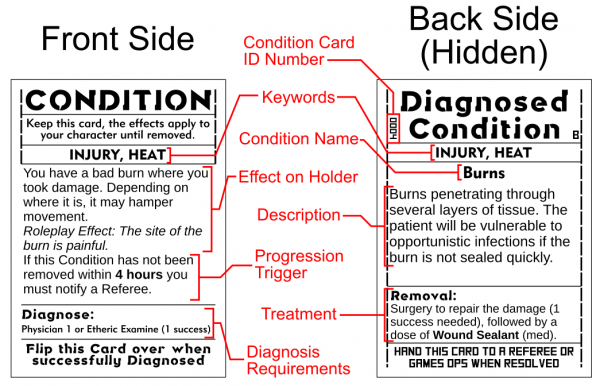 This Condition Card is fairly straightforward - the character has had a nasty burn. The immediate effect on the holder is that its painful, and depending where it is it might make movement difficult (this is up to the player to determine based on their roleplay). Burns has the Type Keywords of INJURY and HEAT - its a pretty common injury, and is connected to being exposed to a heat source (in this case probably heat, fire, an energy weapon, etc). The front side of the card has a Progression Trigger of being left untreated for 4 hours or more.
This Condition Card is fairly straightforward - the character has had a nasty burn. The immediate effect on the holder is that its painful, and depending where it is it might make movement difficult (this is up to the player to determine based on their roleplay). Burns has the Type Keywords of INJURY and HEAT - its a pretty common injury, and is connected to being exposed to a heat source (in this case probably heat, fire, an energy weapon, etc). The front side of the card has a Progression Trigger of being left untreated for 4 hours or more.
The requirements for diagnosis are indicated on bottom of the card. Any Rank 1 Physician can diagnose it automatically - a nasty burn is fairly easy to spot for someone with training. A Scientist can also Examine the Condition to diagnose it - its a Card Draw Action to do so, but only requires 1 success as its pretty easy.
Once the Condition has been diagnosed, the card is flipped over to the back side. On this side there is an ID number (not really important in this case, as all the needed information is here), and also a more detailed description of what the Condition is - very straightforward here, but the cause can be more obscure with many Conditions. This side also has details on how to cure the burn, and what will likely happen if it isn't treated - in this case the holder will get a nasty infection in the open wound.
Once the treatment has been administered and the Burn cured, the card directs the holder or Physician to hand it in to a Referee or Games Ops - this allows the card to be reused in future.
Moderate Chronic Radiation Exposure
This Condition Sheet is a bit more complex. It represents chronic radiation lingering in the body, most likely after an acute dose was treated and removed. The Condition Sheet (above) has the title and Keywords again, but the Symptoms that the character experiences are staged. Characters gaining this Condition for the first time start at Medium Level, and presumably can lessen their symptoms with treatment. Although the Sheet mentions symptoms, it doesn't really have any information about causes or how the Condition works - that kind of information requires a Diagnosis.
The symptoms of this Condition include both mechanical restrictions (the inability to wear heavy armour or carry large weapons) as well as roleplay effects (tiredness and stiff joints). At lower levels, the effects are lessened - the mechanical restriction disappears at Low Level, and the roleplay effects are mostly gone by the Remission Level. However, the Condition Sheet on its own doesn't identify how to get from higher to lower levels. The holder of the sheet should indicate what Level they are currently at - using a pencil to circle or mark the appropriate level is fine.
The requirements to Diagnose are similar to the Burns example above, although slightly more difficult for a Scientist to identify, needing 2 successes. The Sheet also notes that once a Diagnosis is successful, the associated Diagnosis Sheet has ID0024.
The Diagnosis Sheet is a bit more helpful. It tells the Physician or Scientist what is happening to the patient's body, and how to improve their situation. The Diagnosis Sheet also details how the Condition can be treated - a dose of Radiation Nanosponges followed by Med-serum (both Medicaments) will improve the Condition by one level. The catch is that the treatment can only be performed once each event. The holder is likely to feel the effects of the radiation for some time to come. Should have worn a Rad-suit!
Conditions Design
Science fiction media is full of all manner of weird afflictions - from exposure to strange radiation to exotic diseases and the effects of alien technology. The sheer variety and complexity of these sorts of things would be impossible to contain within typical LRP calls and memorised effects - they are simply too long and detailed. Additionally, if all the rules are front-loaded on the players, as well as being a massive amount to remember, it leaves no room for the unknown - the new, strange and alien afflictions that are often part and parcel of exploration and investigation narratives in sci-fi. The inspirations for OSLRP include series like Star Trek and Babylon 5, all of which have plenty of injuries and strange afflictions, and it would be a big loss to the setting to not include anything of that sort.
Conditions are intended to be a framework for creating stories and allowing characters to experience consequences for the risky actions they take, lending additional weight to the choices to take those actions. Entering a radioactive zone to disable a faulty machine, brashly poking around a precursor artefact or taking on a brutish alien monster are cool things for characters to do. Without risks and stakes they lose some of their dramatic edge, while at the same time if the only real lasting bad outcome for a risky act is character death, that acts as a strong discouraging factor. Conditions allow for a middle ground - consequences of failure or taking risks that matter and have impact, while generally not being so severe that they discourage taking the risk in the first place. Most of the time, the risk of acquiring a Condition will be signposted by hints or mission descriptions, but this may not always be the case.
The factors above are the two main pillars of the Condition system - having a framework to represent all manner of weird afflictions that can create stories, and allowing the system to have consequences for taking risks between quickly recoverable damage and character death.
Other reasons for being able to represent more complex afflictions and effects in game we feel are the following:
- Conditions can be an opportunity to roleplay, and potentially a challenge for the character to overcome.
- It adds a significant extra element to Physician characters’ game - who can sometimes be seen as somewhat of a generic method of recovering hits in some LRP systems.
- They enhance the narrative scope around combat, investigation and other large elements of the game.
- They allow for greater characterisation of individual characters suffering from rare afflictions, or an inherent part of a Species’ background.
The Conditions framework is intended to be fairly straightforward in play - when a character gets a Condition, all they need to do is read the card or sheet and adjust their roleplay accordingly. Physician and Scientist characters, who have “bought into” the game space that Conditions occupy, need to know a bit more, but most of the time what they need to do should be fairly self-explanatory. The Keywords system should allow for Conditions to be targeted, and for some characters and species to have advantages or disadvantages when dealing with certain types of Condition - as well as making it easier for Referees to spontaneously deliver or adjudicate a wide range of Conditions in the field.

